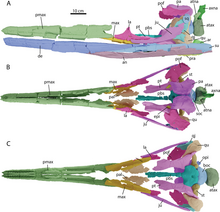Argovisaurus
| Argovisaurus Temporal range: Middle Jurassic
| |
|---|---|

| |
| Holotype block | |
| Scientific classification | |
| Domain: | Eukaryota |
| Kingdom: | Animalia |
| Phylum: | Chordata |
| Class: | Reptilia |
| Order: | †Ichthyosauria |
| Node: | † Ophthalmosauria
|
| Genus: | †Argovisaurus |
| Species: | †A. martafernandezi
|
| Binomial name | |
| †Argovisaurus martafernandezi Miedema et al., 2024
| |
Argovisaurus (meaning "
Discovery and naming
The Argovisaurus
In 2024, Miedema et al. described Argovisaurus martafernandezi as a new genus and species of ophthalmosaurian ichthyosaur based on these fossil remains. The generic name, "Argovisaurus", combines "Argovia", the Latin name of Aargau, where the fossil was discovered, with the Greek "σαῦρος" ("sauros"), meaning "lizard". The specific name, "martafernandezi", honors Marta Fernández and her paleontological work on marine reptiles including ichthyosaurs.[1]
Description

The holotype individual of Argovisaurus likely belonged to an animal between 4.5–6 metres (15–20 ft) long, similar in size to Mollesaurus. Within the Ophthalmosauria, few species outside of the Platypterygiinae grew this large. The mandible of the Argovisaurus is about 125 cm (49 in) long. Several of the bones of the skull and skeleton preserve abnormalities that may be attributable to traumatic injuries.[1]
Classification
In their
| |||||||||||||||||||||||||||||||||||||||||||||||||||||||||||||
